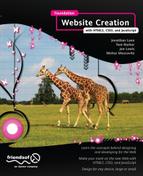Contents
About the Cover Image Designer
Chapter 1: Introducing the Past, Present, and Future of the Web
The standard way of doing things
Every journey starts with a single step: the Web past
Then there were standards: the Web now
A crystal ball: the Web future
Chapter 2: Keeping a Project on Track
The traditional approach to project management
Web project management: the power of iteration
Achieving the goal: identifying doneness
“But the PMI covers nine areas; you’ve talked about only three!”
Profiling professions: Jason Fried
Chapter 3: Planning and High-Level Design
Goals and objectives discussion
User stories and user personas
Profiling professions: Daniel Burka
Chapter 4: Giving Your Pages Structure: HTML5
The href attribute, URLs, and web page addresses
I want moving pictures (and sound)!
Chapter 5: Exploring Fundamental Concepts of CSS
The origins and evolution of Cascading Style Sheets
Applying styles to web page elements
More CSS selectors: targeting page elements with surgical precision
Combining multiple CSS selectors in a single rule
CSS inheritance: making the general case work in your favor
The CSS cascade and the rules of specificity
Visual rendering: document flow and the CSS box model
Chapter 6: Developing CSS3 in Practice: From Design to Deployment
The visual source: understanding design documents
Diving into code: advanced CSS concepts applied
Page structure: laying out the page
Give those form elements some style
A quick note about browser compatibility
CSS media types and creating print style sheets
Designing for other media types and devices
Expressions, white space, semicolons, and minification
Chapter 9: A Deeper Dive Into JavaScript
Philosophy of object-oriented design
Functions as first class objects
Chapter 10: Closing the Loop with JavaScript
Saving and retrieving client side data
JavaScript Unit Tests with Jasmine
Chapter 11: Using Server-Side Technologies
The server side removes barriers
Web servers: dishing out hypertext
Microsoft Internet Information Services (IIS)
A wide range of hosting options
The world outside relational databases
Chapter 12: Using WordPress to Jumpstart Development
Chapter 13: Afterword: The Business of the Web
Basic needs of the freelance web professional
Limited Liability Company (in the United States)
Making money: financial survival
Getting paid (aka accounts receivable)
Finding good resources: people
Hiring: finding the right skills and personality
Finding temporary help: subcontracting
Partnering with others to complement skill sets
Growing your practice and increasing capacity
